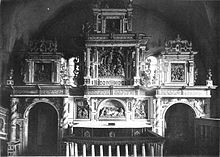Bristow village church
The village church in Bristow, a district of Schorssow in the Rostock district in Mecklenburg-Western Pomerania , is considered the oldest Protestant village church in Mecklenburg. The interior of the church still has numerous decorative elements in the Renaissance style . The parish belongs to the Rostock provost in the Mecklenburg parish of the Evangelical Lutheran Church in Northern Germany ( Northern Church ).
history
The church was donated in the 1590s by Werner von Hahn (1515–1593) from the Basedow house as a simple chapel and magnificently expanded in the Renaissance style by his son Hans Hahn (1558–1633) . The church is a peculiar heavy building made of neatly hewn granite blocks . The year 1597 can be found on the east gable of the flat choir . In 1600 the first pastor was appointed. The altar, pulpit and organ loft are still original from around 1600. A special feature of the furnishings is Werner Hahn's will, carved in four limestone tablets, in which, among other things, the income of the pastors was determined. After the Thirty Years' War the church became a branch church of Hohen Demzin , from 1790 of Bülow .
The ensemble consisting of a church, cemetery and Bassewitz mausoleum was renovated for the first time in 1856. At that time the church was re-roofed, the cemetery was expanded and received a new surrounding wall. In 1876, the originally towerless church was given its west tower under the direction of the Schwerin court architect Georg Daniel , the basement of which will also be the main entrance to the church (instead of the older north portal). In the course of the renovation, the floor, the chairs and the windows of the church were renewed.
During the GDR era, small but no major entertainment measures took place, so that the church had to be closed in 1989 due to the risk of collapse. From 1992 to 2000, the church and the organ, which was destroyed after the war, were extensively renovated, mainly supported by the German Foundation for Monument Protection and the Rudolf August Oetker Foundation .
Furnishing
The altar of the church made of pine and hardwood shows rich Renaissance carvings in eight high reliefs : the birth of Christ (above the passage on the north side), the adoration of the Magi , Last Supper and Christ on the Mount of Olives (in the lower middle part), crucifixion , resurrection and Ascension (all three in the upper middle part) and finally the outpouring of the Holy Spirit (above the passage on the south side). The spandrels of the passageways are decorated with the four evangelist symbols ; behind the Ionic columns flanking the crucifixion stand the apostles Peter and Paul with their attributes key and sword. A number of verse inscriptions refer to the sculptures.
The pulpit is leaning against the altar to the north and is architecturally connected to it. Bas-reliefs with the figures of Jesus Christ and the apostles Peter and Paul are attached to the staircase, the half-figures of the four evangelists on the pulpit, the Christ Child as Salvator Mundi on the pulpit wall , and a number of putti with the instruments of the Passion on the sound cover .
The builder and altar artist of the church extension around 1600 is unknown, but the furnishings show stylistic influences that refer to Prenzlau in the Uckermark or to Ludwig Münstermann's school in the Oldenburg area.
The organ gallery made of pine and hardwood dates from 1601 and is decorated with allegorical representations of the seven liberal arts . The organ itself was built by Friedrich Friese from Schwerin in 1876, destroyed after the Second World War and restored in 1999/2000 by Andreas Arnold from Plau am See.
Werner Hahn's will from 1598 is carved into four limestone tablets in gilded letters, above which an obituary for Werner Hahn and his wife Anna von der Lühe is attached in the same style. In the church there are also the tombstones of Hans Hahn and his first wife Ilse von Arnim. The stone crucifixion group on the southern inner wall was originally on the outside above the old northern main entrance, but was moved to its current location inside in 1995 for conservation reasons.
The choir stalls date from the time the church was built. The stained glass windows in the choir date from the 19th and 20th centuries and show the four evangelists and the coats of arms of the Bassewitz and Bülower families. The baptismal font and other stalls also date from the 19th century.
In the tower of the church there are two bells that were cast by Claus Binke in Wismar in 1598 ; a third bell was lost in the Second World War. The tower clock was installed in 1910.
literature
- Friedrich Schlie : The art and historical monuments of the Grand Duchy of Mecklenburg-Schwerin. Volume 5, Schwerin 1902, pp. 71-79
- The architectural and art monuments in the GDR, Neubrandenburg district , Berlin 1986, p. 406/407.
- Alexander Ensikat: Chronicle Bristow
Web links
- Literature about the village church of Bristow in the state bibliography MV
- bristow.de - Comprehensive website about the Renaissance Church of Bristow
Individual evidence
Coordinates: 53 ° 42 ′ 44 " N , 12 ° 37 ′ 26" E



